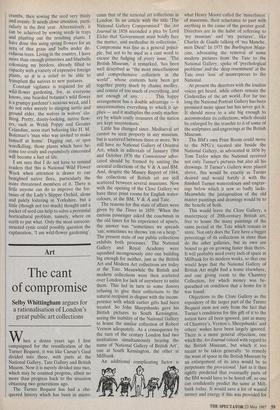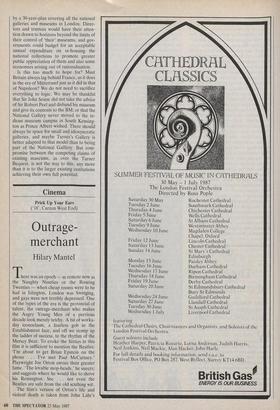Art
The cant of compromise
Selby Whittingham argues for a rationalisation of London's great public art collections When a dozen years ago I first campaigned for the reunification of the Turner Bequest, it was like Caesar's Gaul divided into three, with parts at the National Gallery, Tate Gallery and British Musem. Now it is merely divided into two, which may be counted progress, albeit no more than progress back to the situation obtaining two generations ago.
The Turner Bequest has had a che- quered history which has been in micro-
cosm that of the national art collections in London. In an article with the title 'The National Gallery Compromised ' the Art Journal in 1858 seconded a plea by Lord Elcho that 'Government must boldly face the matter, and methodise its collections.' Compromise was fine as a general princi- ple, but not to be used as a cant word to excuse the fudging of every issue. 'The British Museum,' it remarked, 'has been well described as "the most miscellaneous and comprehensive collection in the world", whose contents have been got together pretty much by chance medley, and consist of too much of everything, and not enough of any. . . This happy arrangement has a double advantage — it unsystematises everything to which it ap- plies — and it multiplies the costly machin- ery by which costly treasures of the nation are kept unsystematic.'
Little has changed since. Mediaeval art cannot be seen properly in any museum, but is scattered between three or more. We still have no National Gallery of Oriental Art, which in editorials of January 1966 and October 1976 the Connoisseur advo- cated should be formed by uniting the oriental collections of the V & A and BM. And, despite the Massey Report of 1944, the collections of British art are still scattered between several museums. Now with the opening of the Clore Gallery we have three print rooms for English water- colours, at the BM, V & A and Tate.
The reasons for this state of affairs were given by the Times in 1859: 'When the curious passenger asked the coachman in the old times for his experience of upsets, the answer was "sometimes we spreads 'em; sometimes we throws 'em on a heap." The present state of our public collections exhibits both processes.' The National Gallery and Royal Academy were squashed incongruously into one building big enough for neither, just as the British Art and Modern Art collections are today at the Tate. Meanwhile the British and modem collections were then scattered over London for lack of anywhere to unite them. This led in turn to some donors refusing to give their collections to the natural recipient in disgust with the incom- petence with which earlier gifts had been treated. So John Sheepshanks gave his British pictures to South Kensington, seeing the inability of the National Gallery to house the similar collection of Robert Vernon adequately. As a consequence by the turn of the century London had two institutions simultaneously bearing the name of 'National Gallery of British Art', one at South Kensington, the other at Millbank.
An additional complicating factor is what Henry Moore called the 'miserliness' of museums, their reluctance to part with anything in the cause of the greater good. Directors are in the habit of referring to `my museum' and 'my pictures', like Charles de Gaulle talking of 'ma Manche, mon Dieu!' In 1975 the Burlington Maga- zine, advocating the removal of some modern pictures from the Tate to the National Gallery, spoke of 'psychological problems' and the 'deep resentment' at the Tate over 'loss' of masterpieces to the National.
At present the directors with the loudest voices get heard, while others remain the Cinderellas of the art world. For far too long the National Portrait Gallery has been promised more space but has never got it. It should move to a site big enough to accommodate its collections, which should be enlarged by the transfer to it of some of the sculptures and engravings at the British Museum.
The BM's own Print Room could move to the NPG's vacated site beside the National Gallery, as advocated in 1856 by Tom Taylor when the National received not only Turner's pictures but also all his drawings. If Turner's Gallery were placed above, this would be exactly as Turner desired and would fortify it with the finished Turner watercolours and engrav- ings below which it now so badly lacks. Meanwhile the juxtaposition of the old master paintings and drawings would be to the benefit of both.
This would leave the Clore Gallery, a masterpiece of 20th-century British art, free to house the many paintings of the same period at the Tate which remain in store. Not only does the Tate have a bigger percentage of its collections in store than do the other galleries, but its own are bound to go on growing faster than theirs. It will probably need every inch of space at Millbank for its modern works, so that one would hope that the National Gallery of British Art might find a home elsewhere, and one giving room to the Chantrey Collection, for which money was be- queathed on condition that a home for it was found.
Objections to the Clore Gallery as the repository of the larger part of the Turner Bequest stem not only from the fact that Turner's conditions for this gift of it to the nation have all been ignored, just as many of Chantrey's, Vernon's, Sheepshanks' and others' wishes have been largely ignored. There is a more general objection, one which the Art Journal voiced with regard to the British Museum, but which it too meant to be taken generally: `to remedy the want of space in the British Museum by an enlargement of its area would be to perpetuate the provisional.' Just as it then rightly predicted that eventually parts of the BM would have to be hived off, so one can confidently predict the same at Mill- bank today. It would save a lot of wasted money and energy if this was provided for by a 30-year-plan covering all the national galleries and museums in London. Direc- tors and trustees would have their atten- tion drawn to horizons beyond the limits of their control of 'their' museums, and gov- ernments could budget for an acceptable annual expenditure on re-housing the national collections to promote greater public appreciation of them and also some economies arising out of rationalisation. Is this too much to hope for? Must Britain always lag behind France, as it does in the era of Mitterrand just as it did in that of Napoleon? We do not need to sacrifice everything to logic. We may be thankful that Sir John Soane did not take the advice of Sir Robert Peel and disband his museum and give its contents to the BM; or that the National Gallery never moved to the te- dious museum campus in South Kensing- ton as Prince Albert wished. There should always be space for small and idiosyncratic galleries, and maybe Turner's Gallery is better adapted to that model than to being part of the National GaIllery. But com- promise between the competing claims of existing museums, as over the Turner Bequest, is not the way to this, any more than it is to the larger existing institutions achieving their own full potential,










































































 Previous page
Previous page